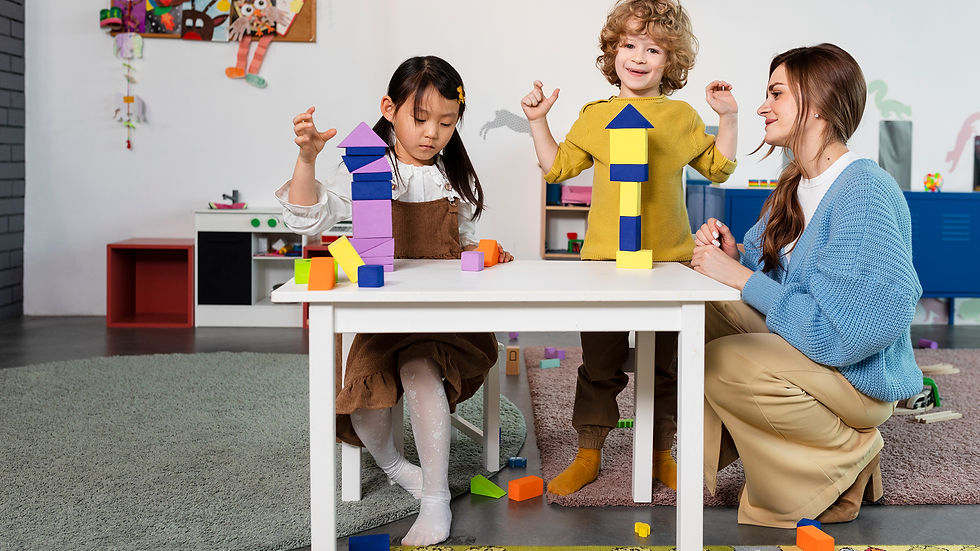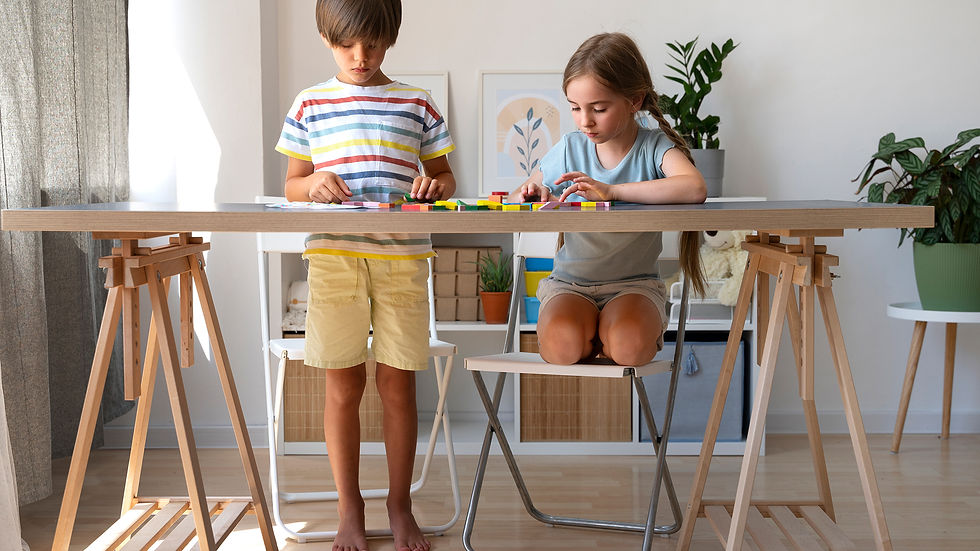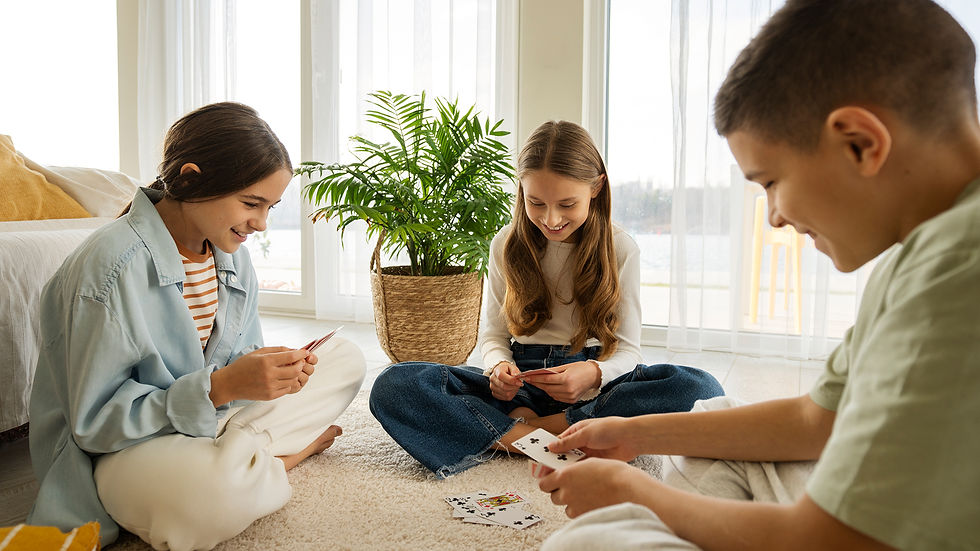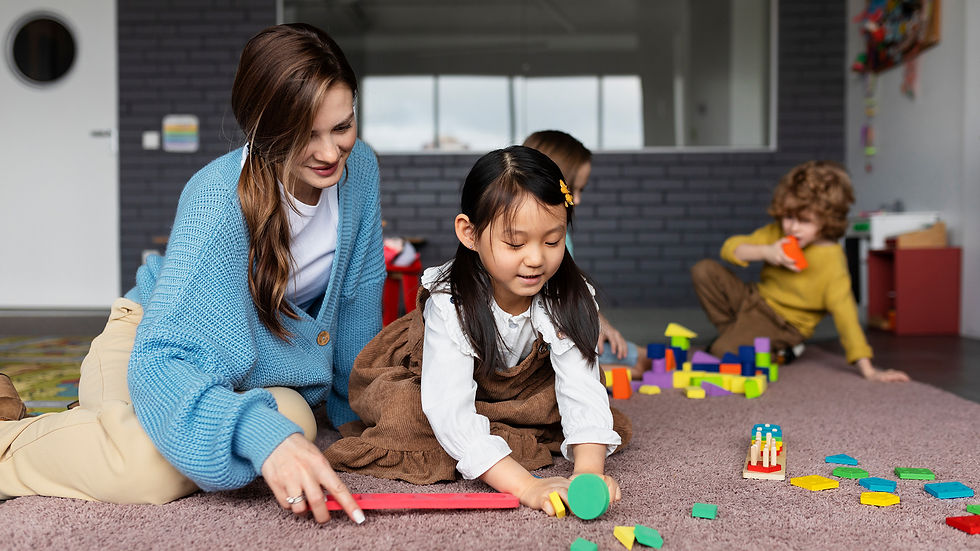Fun and Creative Homeschool Activities for Socialization
- Charles Albanese
- Aug 5
- 8 min read
Updated: Aug 6
In 2025, homeschooling supports both learning and social development. According to 87% of peer-reviewed studies, homeschooled children show the same or even stronger social engagement compared to their peers in traditional schools. With the right activities, families can build strong social skills at home and in the community.
Key Highlights:
According to 87% of peer-reviewed studies, homeschooled children show the same or even stronger social engagement compared to their peers in traditional schools.
Rotational Play Pods… build early friendships, teach sharing, and make social time less chaotic.
Organize monthly STEM or maker challenges where small teams solve a problem. Encourages leadership, negotiation, and group decision-making.
Whether it’s a podcast, a group Etsy shop, or a homeschool newsletter, give teens a reason to plan, create, and deliver as a group.
Consistency is everything. Weekly clubs, annual traditions, or ongoing group projects help friendships stick.
The Importance of Socialization in Homeschooling

One of the first things people ask when they hear you homeschool is, “But what about socialization?” The reality? Social development looks different but is often stronger in a homeschool setting when parents are intentional.
Activities for homeschoolers build social skills in ways that are often more natural and emotionally safe:
Toddlers and preschoolers bond through unstructured playdates, music classes, and sensory activities at local co-ops.
Elementary-aged kids develop teamwork and confidence in homeschool sports leagues, maker groups, and nature hikes with peers.
Older kids often engage through volunteering, Scouts, debate clubs, or project-based learning circles, many of which mix age groups and allow for real mentorship moments.
Studies show that homeschooled students often experience more meaningful peer interactions because age groupings or rigid classroom dynamics do not limit them. They learn to navigate relationships with adults, younger children, and peers in real-world situations, such as grocery trips, community events, or family business projects.
The goal is learning how to cooperate, listen, speak up, compromise, and contribute. Activities for homeschoolers can absolutely support that, and often in more flexible, values-aligned ways than traditional systems allow.
With that foundation in mind, let’s explore some of the best social activities for homeschoolers in 2025, tailored to different age groups.
Best Social Activities for Homeschoolers 2025
Homeschooling doesn’t mean kids miss out on connection. It simply means that social learning occurs more intentionally. Whether you're new to homeschooling or just trying to expand your child’s social world, these activity ideas are grouped by age and built for real homeschool families.
Toddlers and Preschoolers (Ages 2 to 5)

At this age, kids don’t need formal social “lessons”. They need simple, repeatable chances to play, talk, and explore with other children.
Rotational Play Pods
Team up with 2 or 3 other families and take turns hosting themed mornings. Think sensory bins, outdoor art, or story-based games. Kids thrive when they see the same faces regularly and know what to expect.
Why it works: It builds early friendships, teaches sharing, and makes social time less chaotic.
Parent and Tot Movement Classes
Sign up for toddler yoga, music-and-movement, or beginner gymnastics. These classes help toddlers follow group routines and get used to being part of a community.
Why it works: Encourages listening, motor skills, and emotional regulation in a low-pressure setting.
Nature Explorer Walks
Create a mini “explorer group” that meets weekly at a park. Use scavenger lists, nature journaling, or bug hunts to guide social interaction naturally.
Why it works: Offers calm, sensory-rich experiences while supporting language and social curiosity.
Early Elementary (Ages 6 to 8)

This is a great age to introduce more group learning. Kids start to value teamwork, shared goals, and showing what they’ve made or learned.
Hands-On Learning Co-Ops Join or create a co-op where kids can explore art, baking, science, or world cultures. Keep group sizes small and rotate responsibilities between parents. Why it works: Kids practice collaboration while building subject knowledge together.
Also read: Teaching Strategies for Different Age Groups
Clubs with a Purpose Start a LEGO challenge group, beginner gardening team, or kid-run art gallery. Choose projects with clear outcomes so children feel a sense of accomplishment together. Why it works: Gives kids something to work toward as a team, improving cooperation and problem-solving.
Mini Book Circles Instead of full book clubs, do short read-alouds followed by drawing, acting out scenes, or building with blocks based on the story. Why it works: Makes group reading playful while helping kids build confidence in expressing themselves.
Upper Elementary (Ages 9 to 12)
As kids become more independent, social learning becomes about applying skills, resolving conflict, communicating clearly, and navigating roles in group settings.
Team Challenges and Maker Days Organize monthly STEM or maker challenges where small teams solve a problem, building a bridge, designing a trap, or coding a robot.
Why it works: Encourages leadership, negotiation, and group decision-making.
Community Projects or Service Groups Start a group that collects food donations, writes thank-you cards, or helps a local garden. Choose a project that ties into something your child already cares about.
Why it works: Strengthens empathy and peer cooperation while showing kids they can make an impact.
Story Circles and Debate Games Host themed storytelling sessions or fun debates on light topics (“Pancakes vs Waffles”) where kids build arguments and practice respectful listening.
Why it works: Sharpens critical thinking, confidence, and verbal expression, all while having fun.
Preteens and Teens (Ages 12+)

This is where deeper peer collaboration, identity exploration, and leadership really start to matter. The goal is both social time and a purposeful connection.
Project Teams with Real-World Goals Whether it’s a podcast, a group Etsy shop, or a homeschool newsletter, give teens a reason to plan, create, and deliver as a group.
Why it works: Builds long-term collaboration skills, project management, and real-world readiness.
Also read: Comparing Inductive and Deductive Approaches to Teaching Methods
Civic Clubs or Teen Debate CirclesLet teens explore current events or roleplay governance through Model UN-style clubs. You can also organize mock trials or student councils in your homeschool network.
Why it works: Helps them articulate opinions, lead conversations, and appreciate diverse perspectives.
Peer-Led Skill Swaps Give teens the chance to lead classes for younger kids, like Minecraft design, cooking basics, or photography. It’s social learning for both the mentor and the learners.
Why it works: Fosters leadership, public speaking, and cross-age communication.
While these activities offer rich opportunities, their impact depends on how you support and structure them at home.
Tips for Parents to Encourage Homeschool Activities

Even the most engaging activity won’t mean much if it doesn’t fit your child’s needs or if social time feels forced. Here are practical tips to help you make homeschool socialization both consistent and meaningful:
1. Follow your child’s social energy, not your expectations
Some kids thrive in big group settings; others do better with just one or two friends at a time. Start small, observe what they enjoy, and build from there. If your child needs quiet breaks during social time, plan for that too. The goal is quality interaction, not quantity.
2. Treat social time as part of your learning schedule
Just like you’d block out time for math or reading, set aside regular slots for group activities or playdates. It could be a weekly nature co-op, library class, or shared science lab; consistency helps kids feel secure and connected.
3. Lean into your strengths and share the load
You don’t have to organize everything yourself. If you're better at planning than leading, team up with another parent who loves hands-on group time. Homeschool networks, online groups, or even micro-school-style pods can help share the responsibility.
4. Build in space for unstructured time
Not every social activity has to be structured. Sometimes, free play after a co-op class or casual meetups at the park leads to the most authentic peer bonding. Give kids the space to direct the interaction themselves, and it helps develop independence and social instincts.
5. Use interest-led learning as a social tool
Find out what excites your child! Minecraft, baking, storytelling, robotics, and use that as a starting point to connect with others who share that interest. Clubs and group classes built around mutual passion tend to last longer and spark deeper friendships.
To make the most of these social opportunities, here are some simple ways parents can support connection without pressure or burnout.
Conclusion
When you're homeschooling a child with special needs, the focus isn’t on replicating a classroom experience. It's about building trust, using routines that work, and offering social interactions that feel safe and manageable. Whether that means quiet group time, one-on-one peer play, or interest-led projects, the goal is to meet your child where they are and support steady progress.
At The School House Anywhere (TSHA), education isn’t one-dimensional. The American Emergent Curriculum (AEC) combines structured academics with the kinds of experiences that shape well-rounded, emotionally confident learners.
Alongside rigorous learning methods like the Structured Work Cycle, Project-Based Learning, and Critical Thinking & Dialogue, TSHA integrates the best of traditional American schooling, because we know those elements matter too.
Here, students move, perform, lead, and connect:
Sports & Movement programs promote physical wellness and emotional balance through yoga, team sports, and real lessons in sportsmanship
Performing Arts foster creativity, confidence, and collaboration with real instruction and performance opportunities
Civics is taught through experience, not worksheets, giving kids leadership roles and an understanding of democracy from the inside out
Economic Diversity remains a core value, making TSHA accessible and richer through a variety of lived experiences
Whether you're homeschooling a toddler or managing a micro-school, TSHA supports children ages 3–12 with a developmentally aligned, screen-free curriculum that honors who they are and how they learn best.
Join TSHA to access the AEC curriculum, real-world learning resources, and 24/7 support from experienced educators. Help your child build not just academic knowledge, but confidence, creativity, and a lifelong connection.
FAQs
1. My child is neurodivergent and gets overwhelmed in group settings. How do I support social development without pushing too hard?
Many homeschoolers in this situation start with predictable, low-sensory environments like one-on-one nature walks, building projects with a peer, or virtual interest-based communities with the camera off. Slowly increasing the group size or social duration over time allows kids to build confidence without burnout.
Also read: AI for Special Education: A Detailed Guide
2. We live in a rural area with very few homeschoolers nearby. How can I still give my child social opportunities?
Many rural families create “micro circles” by combining different age groups or even involving extended family, neighbors, or online project partners. Don’t underestimate the social value of real-life tasks, like 4H, volunteering at local farms, or running a roadside produce stand with peers.
3. My 10-year-old only wants to socialize online. Should I be worried?
It depends on what “socializing” looks like. If they’re engaging in online classes, group gaming with voice chat, or creating content collaboratively, they are learning modern social cues, especially relevant post-2020. You can balance this with offline peer interactions like board game nights, DnD groups, or co-op events they help plan.
4. Our homeschool group feels too cliquey, and my child isn’t fitting in. What should I do?
This is more common than people admit. Try branching out to interest-based clubs (such as chess, coding, or community theatre) where social bonds form around shared goals, rather than just age or educational style. Sometimes switching groups entirely is healthier than “trying to make it work.”
5. How do you handle socialization if your homeschooling style is more independent or unschooling?
Unschoolers often build social routines around real-life contexts, such as community service, maker events, local meetups, or group travel. The key is to let the child’s passions lead and look for authentic interaction, not forced participation. A teen interested in film might bond faster in a small film-editing workshop than in a general co-op.
6. What’s the best way to maintain long-term friendships in homeschooling?
Consistency is everything. Weekly clubs, annual traditions (like a family camp), or ongoing group projects help friendships stick. Let kids connect in multiple settings, like online, outdoors, and over lunch, to deepen the bond. Friendships often outlast the group if nurtured intentionally.






Comments